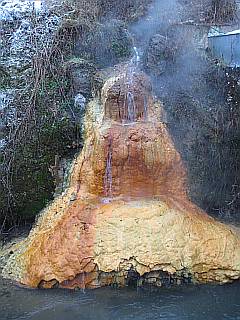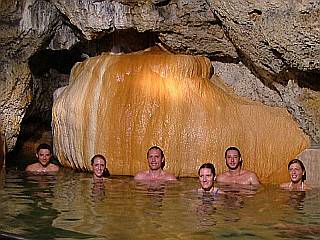Travertin - Sklene Teplice
(Travertine - Sklene Teplice)


Jeden z
travertinov
Travertin
v Sklenych Tepliciach
Na uvedenych suradniciach, pri potoku, pod kopcom, na ktorom stoji
dedinsky kostol sa nachadzaju tri travertinove kopy. Tieto tri kopy
su stale zive. Boli vytvorene vodou vytekajucou z teplych pramenov.
Maju vysku asi 2m a za ich sfarbenie su zodpovedne jednak bakterie
zijuce vo vode a jednak mineraly a zelezo rozpustene vo vode.
Cely vrch, na ktorom je postaveny kostol je obrovska travertinova
kopa a tri zive travertiny su len niektore z doteraz zive
travertiny v Sklenych Tepliciach. Najznamenjsi zivy traverrtin je
Parenica v kupeloch Sklene Teplice
Niekolko kilometrov od Sklenych Teplic sa v obci Vyhne nachadza
travertin, ktory vznikol ludskou cinnostou a ma prakticky identicke
zlozenie, pretoze podzemny zdroj pramenitej vody je rovnaky. V
tejto oblasti boli prvy krat opisane zelezite bakterie rodu
Gallionella.
Travertin
Travertín je druh vápenca, vznikajúceho vyzrážaním z
sladkovodných minerálnych, prípadne termálnych pramenov.
Mineralogicky je zložený z aragonitu, ktorý však býva
prekryštalizovaný do trigonálnej modifikácie kalcitu,
najcastejšia prímes býva limonit.
Travertín vzniká sedimentáciou, vyzrážaním z vôd obohatených
na CaCO3. Na jeho tvorbe sa môžu výrazne podielat riasy, alebo
rastliny, ktoré z vody odoberajú CO2, cím je urýchlené
vyzrážavanie CaCO3. Prostredia vzniku travertínov sú
však rôzne. Väcšinou sú viazané na prechod vody
karbonátovými horninami. Bežné sú pri výveroch minerálnych vôd
pozdlž mladých zlomových línií. V podzemnom krase dochádza k
velmi pomalému vyzrážavaniu z presakujúcich vôd, cím vznikajú
sintrové kvaple. Za spoluúcasti organizmov môžu vznikat aj v
tecúcej vode potokov a riecnych dolín a nív, najcastejšie na
úpätí svahov. Diageneticky premenený starši travertín sa
mení na vápenec. Travertíny casto obsahujú odtlacky rastlín
(inkrustácia), alebo i dobre zachované fosílie. V okolí pramenísk
vznikajú travertínové kopy, alebo v údoliach kaskády (napr. Staré
Hory). Travertín vzniká aj v súcasnosti. Priesakom minerálnych vôd
do štrkových súvrství vznikajú travertínové zlepence.
Zdroj: sk.wikipedia.org

Kupele
Sklene Teplice
Kupele
Sklene Teplice
V Sklenych Tepliciach vyviera 14 pramenov s teplotou od 37 °C do
52,3 °C. Vyuzivaju sa aj umele hlbkove vrty a studne az do hlbky
1600 m. Su to najvyznamnejsie pramene vulkanickeho pasma. Patria k
prirodnym slabo mineralizovanym, horucim, hypotonickym vodam.
Vlastnosti termalnych vod predurcili kupele v Sklenych Tepliciach
na liecbu pacientov s nervovymi chorobami a chorobami pohyboveho
aparatu.
Prístup ku
Keške
Koordinaty Vas privedu ku trom travertinovym vodopadom, ktoré
vznikli a dalej rastu, v miestach vyverov mineralnych pramenov
vlievajucich sa do miestneho potoka Tepla. Parkujte na uvedenych
suradniciach (PARK).
Ak chcete logovat túto keš, odfotte sa s GPS (alebo alebo
len GPS) pred budovou kupelov (dobrovolne). Tiež je potrebné
zodpovedat nasledujúce otázky a odpovede poslat cez e-mail bud mne
cez profil, alebo Sleepy Ghost-ovi cez tento link:
- Popiste farbu a tvar kazdeho z troch travertinovych
vodopadov.
- Popiste vlastnymi slovami co si myslite, ze preco je kazdy
travertin inej farby.
- Miestny kostol stoji na kopci nad travertinmi. Kopec je vlastne
obrovsky travertin. Aku ma tento travertinovy vrch farbu a vysku od
potoka ? (pouzi GPS)
Kes kludne logujte, nemusite cakat na potvrdenia spravnych
odpovedi.
Ak odpovede budu nespravne, alebo neuplne a pod., budem Vas
kontaktovat emailom. Pokial ale Vas email nepride do 3-och dni po
logu, log bez upozornenia mazem.


One of the
travertines
Travertines in Sklene Teplice
At the coordinates given, near the stream below the hill on which
stands the church are three travertines. These three travertine
piles are still alive. They were created by running water from warm
springs. Each of them has a height of about 2m and both, bacteria
living in the water and minerals and iron dissolved in water are
responsible for their color.
The whole hill on which the church is built is huge travertine hill
and these three travertines are few of the travertines still alive
in Sklene Teplice. The famous travertine still alive is 'Parenica'
in Sklene Teplice Spa
There is a travertine in Vyhne village near Sklene Teplice which
was created by human activities. The composition of this travertine
is identical to those in Sklene Teplice, because the underground
spring water source is the same. Genus Gallionella iron bacteria
was first described in this area.
Travertine
Travertine is a form of limestone deposited by mineral springs,
especially hot springs. Travertine often has a fibrous or
concentric appearance and exists in white, tan and cream-colored
varieties. It is formed by a process of rapid precipitation of
calcium carbonate, often at the mouth of a hot spring or in a
limestone cave. In the latter it can form stalactites, stalagmites
and other speleothems.
Travertine forms the stalactites and stalagmites of limestone
caves, and the filling of some veins and hot spring conduits.
Travertine forms from geothermal springs and is often linked to
siliceous systems which form siliceous sinter. Macrophytes,
bryophytes, algae, cyanobacteria and other organisms often colonise
the surface of travertine and are preserved, giving travertine its
distinctive porosity. Some springs have temperatures high enough to
exclude macrophytes and bryophytes from the deposits, consequently,
deposits are generally less porous than tufa. Thermophilic microbes
are important in these environments and stromatolitic fabrics are
common. When deposits are apparently devoid of any biological
component, they are often referred to as calcareous sinter.
Zdroj: en.wikipedia.org

Sklene
Teplice Spa
Sklene
Teplice Spa
There are 14 springs in Sklene Teplice with temperatures ranging
from 37 ° C to 52.3 ° C. Some artificial boreholes and wells are up
to 1600m deep. They are the most important springs of this volcanic
belt. The springs belong to natural slightly mineralized hot,
hypotonic water. Thermal water spas in Sklene Teplice are used to
treat patients with neurological diseases and musculoskeletal
diseases thanks to the properties of this mineral water.
Access to
the cache
Coordinates given are for three travertine waterfalls witch were
created and still are growing in the points where mineral springs
jet. Water is runnig down to the local creek Tepla (The warm
creek). Park on coordinates given (PARK).
To claim this cache you should take a photo of you with a GPS (or
your GPS only) in front of the main building of Sklene Teplice Spa
(optional). You also need to email me (via the link to my profile
at the top of the page or to Sleepy Ghost via this link) with the
answers to the following questions:
- Describe colour and shape of each of three travertine
waterfalls.
- Describe in your own words, why each travertine has got
different colour.
- The local church was built on the hill above travertines. This
hill is one huge travertine hill. What is the colour and the height
of this travertine hill from the creek? (use GPS)
Feel free to log this cache. You may not wait for permission to
log.
If your answers are not correct, incomplete etc., i will contact
you by e-mail. But if your e-mail is not comming to me without 3
days, I will delete your log without notice.